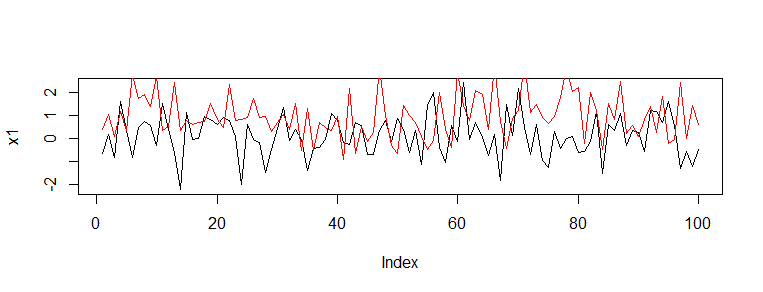найти точки пересечения в р
у меня есть 2 вектора:
set.seed(1)
x1 = rnorm(100,0,1)
x2 = rnorm(100,1,1)
Я хочу построить их как линии, а затем найти точки пересечения линий, также если есть несколько точек пересечения, то я хочу найти каждый из них.
я столкнулся с аналогичным вопросом и попытался решить эту проблему, используя spatstat, но я не смог преобразовать мой комбинированный фрейм данных, содержащий оба векторных значения в psp object.
3 ответов
Если у вас буквально есть два случайных вектора чисел, вы можете использовать довольно простой метод, чтобы получить пересечение обоих. Просто найти все точки, где x1 выше x2, а затем ниже его в следующей точке или наоборот. Это точки пересечения. Затем просто используйте соответствующие склоны, чтобы найти Перехват для этого сегмента.
set.seed(1)
x1=rnorm(100,0,1)
x2=rnorm(100,1,1)
# Find points where x1 is above x2.
above<-x1>x2
# Points always intersect when above=TRUE, then FALSE or reverse
intersect.points<-which(diff(above)!=0)
# Find the slopes for each line segment.
x1.slopes<-x1[intersect.points+1]-x1[intersect.points]
x2.slopes<-x2[intersect.points+1]-x2[intersect.points]
# Find the intersection for each segment.
x.points<-intersect.points + ((x2[intersect.points] - x1[intersect.points]) / (x1.slopes-x2.slopes))
y.points<-x1[intersect.points] + (x1.slopes*(x.points-intersect.points))
# Plot.
plot(x1,type='l')
lines(x2,type='l',col='red')
points(x.points,y.points,col='blue')

вот альтернативный код пересечения сегментов-сегментов,
# segment-segment intersection code
# http://paulbourke.net/geometry/pointlineplane/
ssi <- function(x1, x2, x3, x4, y1, y2, y3, y4){
denom <- ((y4 - y3)*(x2 - x1) - (x4 - x3)*(y2 - y1))
denom[abs(denom) < 1e-10] <- NA # parallel lines
ua <- ((x4 - x3)*(y1 - y3) - (y4 - y3)*(x1 - x3)) / denom
ub <- ((x2 - x1)*(y1 - y3) - (y2 - y1)*(x1 - x3)) / denom
x <- x1 + ua * (x2 - x1)
y <- y1 + ua * (y2 - y1)
inside <- (ua >= 0) & (ua <= 1) & (ub >= 0) & (ub <= 1)
data.frame(x = ifelse(inside, x, NA),
y = ifelse(inside, y, NA))
}
# do it with two polylines (xy dataframes)
ssi_polyline <- function(l1, l2){
n1 <- nrow(l1)
n2 <- nrow(l2)
stopifnot(n1==n2)
x1 <- l1[-n1,1] ; y1 <- l1[-n1,2]
x2 <- l1[-1L,1] ; y2 <- l1[-1L,2]
x3 <- l2[-n2,1] ; y3 <- l2[-n2,2]
x4 <- l2[-1L,1] ; y4 <- l2[-1L,2]
ssi(x1, x2, x3, x4, y1, y2, y3, y4)
}
# do it with all columns of a matrix
ssi_matrix <- function(x, m){
# pairwise combinations
cn <- combn(ncol(m), 2)
test_pair <- function(i){
l1 <- cbind(x, m[,cn[1,i]])
l2 <- cbind(x, m[,cn[2,i]])
pts <- ssi_polyline(l1, l2)
pts[complete.cases(pts),]
}
ints <- lapply(seq_len(ncol(cn)), test_pair)
do.call(rbind, ints)
}
# testing the above
y1 = rnorm(100,0,1)
y2 = rnorm(100,1,1)
m = cbind(y1, y2)
x = 1:100
matplot(x, m, t="l", lty=1)
points(ssi_matrix(x, m))
поздний ответ, но вот "пространственный" метод с использованием пакета SP и RGEOS. Это требует, чтобы x и y были числовыми (или могут быть преобразованы в числовые). Проекция произвольна, но epsg: 4269, казалось, работал хорошо:
library(sp)
library(rgeos)
# dummy x data
x1 = rnorm(100,0,1)
x2 = rnorm(100,1,1)
#dummy y data
y1 <- seq(1, 100, 1)
y2 <- seq(1, 100, 1)
# convert to a sp object (spatial lines)
l1 <- Line(matrix(c(x1, y1), nc = 2, byrow = F))
l2 <- Line(matrix(c(x2, y2), nc = 2, byrow = F))
ll1 <- Lines(list(l1), ID = "1")
ll2 <- Lines(list(l2), ID = "1")
sl1 <- SpatialLines(list(ll1), proj4string = CRS("+init=epsg:4269"))
sl2 <- SpatialLines(list(ll2), proj4string = CRS("+init=epsg:4269"))
# Calculate locations where spatial lines intersect
int.pts <- gIntersection(sl1, sl2, byid = TRUE)
int.coords <- int.pts@coords
# Plot line data and points of intersection
plot(x1, y1, type = "l")
lines(x2, y2, type = "l", col = "red")
points(int.coords[,1], int.coords[,2], pch = 20, col = "blue")


